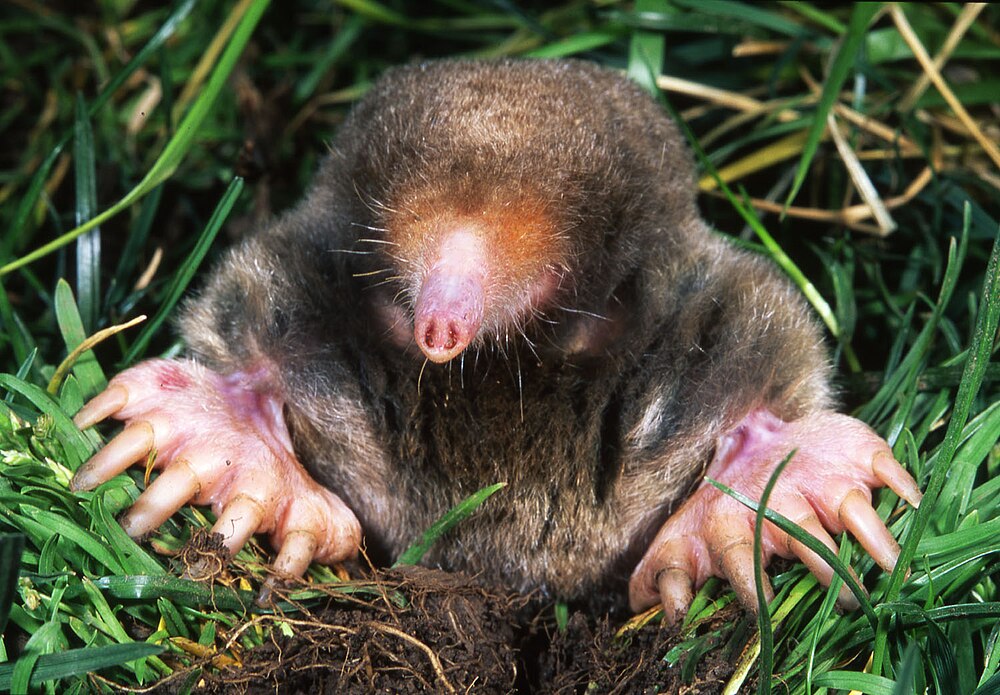What is the maximal age a Eastern mole reaches?
An adult Eastern mole (Scalopus aquaticus) usually gets as old as 6.17 years.
Eastern moles are around 42 days in the womb of their mother. When born, they weight 5 grams (0.01 lbs) and measure 4 cm (0′ 2″). As a member of the Talpidae family (genus: Scalopus), a Eastern mole caries out around 3 little ones per pregnancy, which happens around 1 times a year. Fully grown, they reach a bodylength of 12.5 cm (0′ 5″).
As a reference: Usually, humans get as old as 100 years, with the average being around 75 years. After being carried in the belly of their mother for 280 days (40 weeks), they grow to an average size of 1.65m (5′ 5″) and weight in at 62 kg (137 lbs), which is obviously highly individual.

The eastern mole or common mole (Scalopus aquaticus) is a medium-sized, overall grey North American mole and the only member of the genus Scalopus. Its large, hairless, spade-shaped forefeet are adapted for digging. The species is native to Canada (Ontario), Mexico, and the eastern United States, and has the widest range of any North American mole.The species prefers the loamy soils found in thin woods, fields, pastures, and meadows, and builds both deep and shallow burrows characterized by discarded excess soil collected in molehills. Its nest is composed of leaves and grasses, and its two to five young are on their own at about four weeks. Its diet consists principally of earthworms and other soil life, but the eastern mole will also eat vegetable matter.Dogs, cats, foxes, and coyotes prey upon the eastern mole, and the species hosts a variety of parasites. Unlike gophers, moles do not eat vegetation and pose no threat to human concerns; the occasional damage to lawns is offset by the aeration provided the soil and consumption of insects. The construction of golf courses has provided the mole with ideal habitat. The species is abundant, occurs in protected areas, faces no major threats and is of little concern to conservationists.
Animals of the same family as a Eastern mole
Not really brothers and sisters, but from the same biological family (Talpidae):
- Himalayan mole becoming 1.5 years old
- Small Japanese mole becoming 3.5 years old
- Japanese mountain mole becoming 3 years old
- Père David’s mole with 3 babies per pregnancy
- Inquisitive shrew mole getting as big as 7.5 cm (0′ 3″)
- Townsend’s mole becoming 1.5 years old
- Balkan mole bringing the scale to 70 grams
- Large mole with 3 babies per pregnancy
- Star-nosed mole becoming 3 years old
- Blind mole bringing the scale to 70 grams
Animals that reach the same age as Eastern mole
With an average age of 6.17 years, Eastern mole are in good companionship of the following animals:
- White-bellied duiker usually reaching 5.25 years
- Rufous horseshoe bat usually reaching 5 years
- Yellow-pine chipmunk usually reaching 5.17 years
- Northern bettong usually reaching 7 years
- Black-tailed jackrabbit usually reaching 6.75 years
- Hispid cotton rat usually reaching 5.17 years
- Spinifex hopping mouse usually reaching 5.17 years
- European mole usually reaching 7 years
- Evening bat usually reaching 5 years
- Pyrenean desman usually reaching 5 years
Animals with the same number of babies Eastern mole
The same number of babies at once (3) are born by:
- Mountain hare
- Crawford’s gray shrew
- Hispid hare
- Little native mouse
- Elias’s Atlantic spiny rat
- Fat sand rat
- Mountain pygmy possum
- Chinese bamboo rat
- Woodland dormouse
- Alpine pika
Weighting as much as Eastern mole
A fully grown Eastern mole reaches around 87 grams (0.19 lbs). So do these animals:
- Strong-tailed Oldfield mouse with 77 grams
- Geoffroy’s rousette with 74 grams
- Aegialomys xanthaeolus with 79 grams
- Harrington’s rat with 90 grams
- Ashy-bellied Oldfield mouse with 77 grams
- Durango chipmunk with 85 grams
- White-tailed antelope squirrel with 104 grams
- Woodland Oldfield mouse with 77 grams
- Big-eared kangaroo rat with 78 grams
- Highland streaked tenrec with 102 grams
Animals as big as a Eastern mole
Those animals grow as big as a Eastern mole:
- White-footed vole with 10.3 cm (0′ 5″)
- Southern red-backed vole with 10.1 cm (0′ 4″)
- Pygmy tarsier with 10 cm (0′ 4″)
- Painted spiny pocket mouse with 11.4 cm (0′ 5″)
- Spectral tarsier with 12 cm (0′ 5″)
- California vole with 13.9 cm (0′ 6″)
- South African pouched mouse with 11.7 cm (0′ 5″)
- San José Island kangaroo rat with 10.2 cm (0′ 5″)
- Mountain spiny pocket mouse with 11 cm (0′ 5″)
- Cape York melomys with 13.6 cm (0′ 6″)
